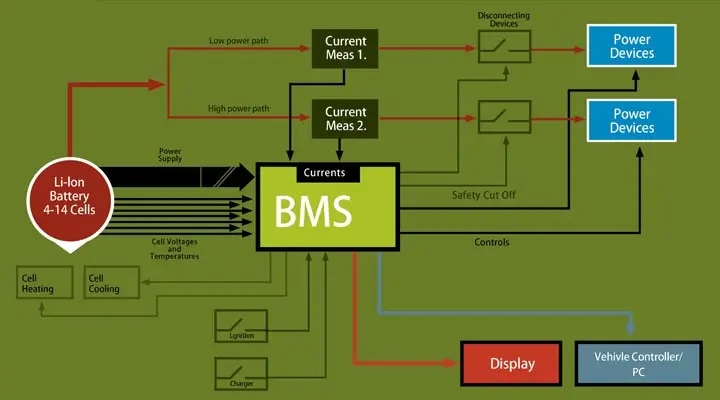Why do power lithium batteries need a battery management system? Currently vigorously developed new energy vehicles are mainly divided into three categories: Hybrid Electric Vehicle (HEV), Fuel Cell Electric Vehicle (FCEV) and Pure Electric Vehicle (Electric Vehicle, EV). These three types of electric vehicles have their own different characteristics and are also in different development stages due to their different structures and working principles.
Pure electric vehicles use on-board power battery packs (such as lithium-ion batteries, lead-acid batteries, nickel-metal hydride batteries and nickel-cadmium batteries, etc.) as their only energy source, and are equipped with high-power motors to drive the car. Therefore, it is different from traditional internal combustion engine vehicles.
The biggest difference is the electric drive and control system unique to pure electric vehicles. Compared with hybrid electric vehicles, pure electric vehicles have low noise, no pollution, zero emissions, and a simpler chassis structure; compared with fuel-powered cell vehicles, all aspects of technology are relatively more mature, with higher reliability and safety. Therefore, pure electric vehicles have been highly valued by governments and car companies around the world, and many companies have achieved batch processing and started demonstration operations in some regions.

In pure electric vehicles, the power lithium battery pack, as one of the core components, occupies a very high proportion in the manufacturing cost of the whole vehicle, and its performance also directly affects the driving performance and safety of the whole vehicle. Most of the power lithium batteries used in early pure electric vehicles were lead-acid batteries.
Due to their low energy density, short cruising range and short service life, these batteries were gradually replaced by products such as lithium-ion batteries with outstanding advantages. Lithium-ion batteries have attracted the attention and use of many electric vehicle manufacturers at home and abroad due to their advantages such as high charging and discharging efficiency, high energy density and strong endurance.
Although lithium-ion batteries have more advantages than other types of batteries, they are also limited by factors such as cell materials and current manufacturing processes, resulting in differences in internal resistance, capacity, and voltage between single-cell lithium-ion batteries. Therefore, in actual use, the individual cells inside the battery pack are prone to uneven heat dissipation or excessive charge and discharge. Over time, these batteries in poor working conditions are likely to be damaged in advance, and the overall life of the battery pack will be greatly shortened.
Not only that, the battery is in a serious overcharged state and there is a danger of explosion, causing damage to the battery pack and threatening the safety of the user’s life. Therefore, it is necessary to equip the power lithium battery pack on the electric vehicle with a set of targeted battery management system (Battery Management System, BMS), so as to effectively monitor, protect, balance the energy and alarm the failure of the battery pack, thereby improving the overall power lithium battery The working efficiency and service life of the battery pack.
As the monitoring and management center of pure electric vehicle power lithium battery packs, the battery management system has to monitor the temperature, voltage, charge and discharge current and other related parameters of the battery pack in real time and dynamically, and take the initiative to take emergency measures to protect each single battery when necessary. Be alert to the dangers of overcharge, overdischarge, overheating and short circuit of the battery pack.
In addition, the system also has to accurately estimate the SOC of the battery during the entire life cycle of the battery pack, and timely feed back key information such as remaining power, driving range and abnormal faults to the driver in a suitable way, and at the same time in an appropriate way. An appropriate way to complete the data exchange function between the system and the vehicle ECU or host computer.
However, these are the functions and performances that BMS can only achieve under optimal design and ideal conditions. At present, all kinds of electric vehicle accidents related to power lithium batteries or the actual use of BMS products in automobiles are as a whole. It can be seen from the performance that the functions of the widely used battery management system are not perfect enough, the technology is not mature enough, the scope of use is limited, and the versatility is not strong. The details can be summarized in the following five aspects:
① The battery management system is not accurate enough to collect the relevant parameters of the power lithium battery pack in the case of long-term use.
② The battery management system cannot fully realize the accurate estimation of the SOC value of the power lithium battery pack during the entire life cycle.
③ The control effect of the energy balance between the individual cells in the battery pack needs to be further improved.
④The self-diagnosis and self-maintenance functions of the battery management system for itself and the battery pack are not perfect.
⑤ The current battery management system products are generally targeted, the scope of use is limited, and the portability and versatility are not strong enough.




